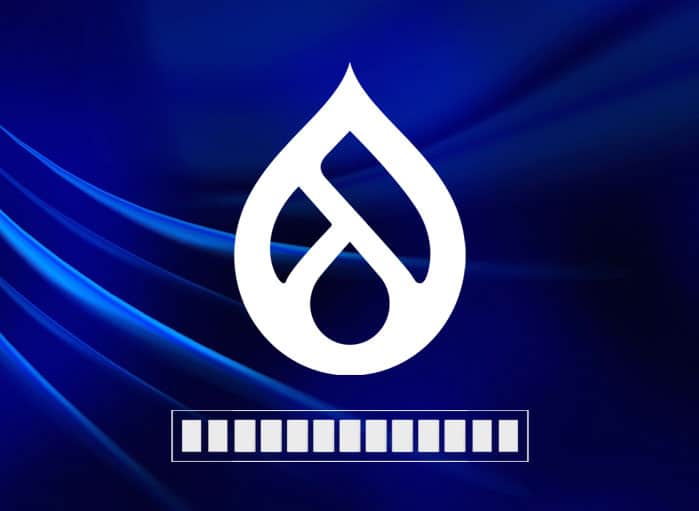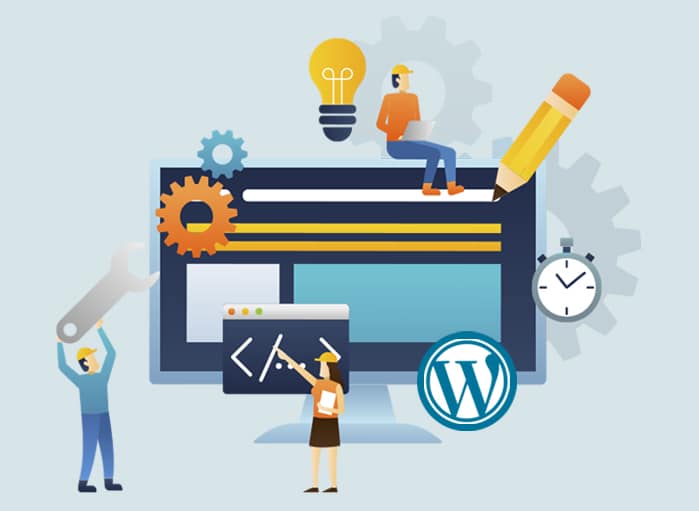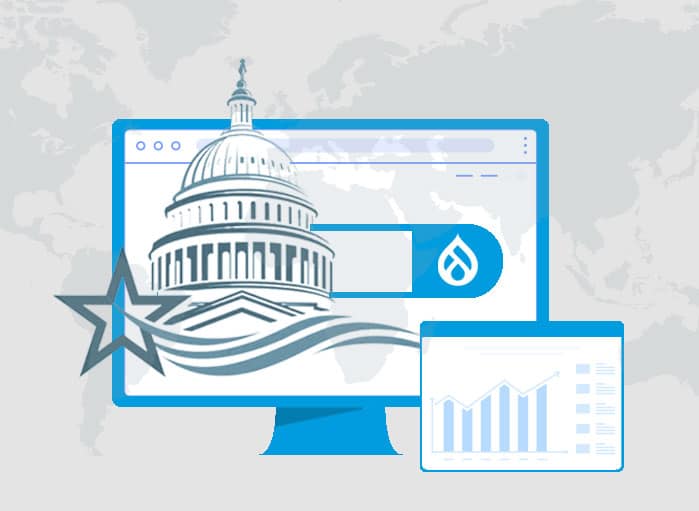
Upgrade to Drupal 10: Experience the Future of Web Development
Tags: Drupal 10,Updates


Are you still using an outdated version of Drupal? It’s time to upgrade to Drupal 10, the latest version of Drupal CMS. Well, in the latest version, i.e., D10 one gets to see a host of new features and improvements that make it a top choice for businesses looking to create and maintain their online presence.
Basically, by upgrading to Drupal 10, businesses can easily take their website to new heights by offering an excellent user experience. Also, the Drupal 10 upgrade is an excellent choice for all those who want to keep their website secure while ensuring it performs well.

1. The Power of Drupal 10
If you’re running a website on Drupal, you’re already aware of the power of the platform. Drupal is one of the most popular open-source content management systems used to build highly scalable and flexible websites. With Drupal 10’s release, there are even more reasons why you should consider upgrading your Drupal website to the latest version.
In this blog post, let’s take you through the importance of the Drupal 10 upgrade and how it’s essential for your website’s success. Also, in this post, you will be able to explore the new features of Drupal 10 and how upgrading to this latest version can benefit your website.
2. Upgrade to Drupal 10: Why it’s Important?
As with any software platform, it’s important to keep your website updated to ensure it’s secure, efficient, and performs well.
Drupal 10 is the latest version of Drupal. The Drupal 10 release happened in June 2022, and is designed to help developers create engaging and immersive digital experiences.
In other words, as technology advances, keeping up with the latest updates is critical for any business. Upgrading your website to Drupal 10 is a must if you want to stay ahead of the curve.
Let’s take you through the importance of upgrading to Drupal 10 and why businesses should consider making the switch.
2.1. Cost-Effective Solution
The process behind an upgrade to Drupal 10 may seem like a significant investment, but in the long run, it can be a cost-effective solution for your business.
By upgrading to the latest version of Drupal, you can avoid costly security breaches and downtime caused by outdated technology. This means that you can save money in the long run and improve your bottom line.
2.2. Compatibility with Latest Technologies
As technology continues to evolve, it is important to stay up to date with the latest tools and technologies. Once you upgrade to Drupal 10 it will ensure that your website is compatible with the latest technologies and platforms. This will give you a competitive edge in the marketplace and help you stay ahead of your competitors.
2.3. Enhanced Performance
The next important reason behind the upgrade to Drupal 10 is enhanced performance. Drupal 10 is designed to be faster and more efficient, which will make a website run smoothly and provide a better user experience.
With faster load times, your website visitors will be more likely to stay on your site longer and engage with your content, leading to higher conversion rates.
2.4. Improved Security
Well, the biggest reason to upgrade to Drupal 10 is the improved security. With the ever-increasing risk of cyber threats, keeping your website secure is more important than ever.
Drupal 10 has the latest security features, making it more difficult for hackers to exploit any vulnerabilities. This means that your business and customer data will be better protected, giving you peace of mind.
2.5. Improved User Experience
Thirdly, businesses should think about the upgrade to Drupal 10 as it is going to improve the user experience of their website visitors. D10 comes with several new features and enhancements that make any website easier to use and navigate.
This means that website visitors will be able to find what they are looking for quickly and easily, leading to a more positive experience for the brand.
3. Drupal 10: The Most Popular CMS at Present
In the CMS world, Drupal 10 is the undisputed king at present. There is a reason behind it. So, let’s dive in to see why choose Drupal 10 and how it surpasses other versions:

3.1. Qualities That Make Drupal 10 The Popular CMS Over Other Platforms?
Before you opt for the upgrade to Drupal 10 service, you must know that Drupal has been powering over 800,000 websites globally. Since the release of Drupal 10, it has only become more powerful, flexible, and user-friendly.
Here’s why businesses can’t get enough of Drupal 10.
3.1.1. Unmatched Flexibility
Drupal 10’s open-source architecture allows developers to build virtually any type of website, from simple blogs to complex e-commerce platforms. With thousands of modules and themes available, the sky’s the limit!
3.1.2. Enhanced Security
Security is a top priority for businesses, and Drupal 10 delivers. Its robust security features, regular updates, and the dedicated Drupal Security Team ensure that your website remains secure and protected against vulnerabilities.
3.1.3. Improved Scalability
As your business grows, so should your website. Drupal 10’s built-in caching and performance optimization features make it the perfect choice for handling websites with high traffic volumes and complex content structures.
3.1.4. SEO Friendly
A CMS that doesn’t help your website rank well on search engines is no good. Luckily, Drupal 10 offers numerous SEO modules that help improve your website’s visibility and search engine rankings, driving more organic traffic to your site.
3.1.5. API-First Architecture
The API-first architecture in Drupal 10 simplifies the integration with third-party applications and services, allowing you to build feature-rich websites and applications with ease.
3.1.6. Backward Compatibility
Drupal 10 ensures seamless migration from previous versions, allowing you to leverage your existing Drupal investments while enjoying the benefits of the latest features.
3.1.7. Extensive Module Ecosystem
Drupal 10 offers an extensive collection of modules and themes, providing greater customization options to suit your specific requirements.
3.1.8. Enhanced Performance
Drupal 10 features significant performance improvements, ensuring your website or application loads faster and provides a seamless user experience. The optimized caching system and support for modern web standards ensure efficient performance across devices.
3.1.9. Mobile-First Approach
Drupal 10 is designed with a mobile-first approach, ensuring your website or application is responsive and delivers an exceptional experience across devices.
3.1.10. Strong Community Support
The Drupal community is dedicated to the platform’s continuous improvement, providing timely updates, bug fixes, and security patches.
3.1.11. User-Friendly Interface
The intuitive and user-friendly interface in Drupal 10 simplifies content management for both developers and non-technical users. The drag-and-drop functionality, improved media management, and layout builder enhance the content editing experience.
Basically, Drupal 10 has raised the bar in terms of performance, security, usability, and flexibility. By adopting this latest version, business houses can build cutting-edge websites and applications that stand out in today’s competitive digital landscape.
In other words, when it comes to selecting a Content Management System (CMS) for a website, Drupal stands out as a powerful choice. In the world of Content Management Systems (CMS), Drupal 10 has been a game-changer since it offers a great digital experience for both developers and end-users.

4. Why do businesses choose Drupal 10?
Let’s delve into the details of why businesses are choosing Drupal 10 over other CMS platforms,
4.1. Lower Total Cost of Ownership (TCO)
Compared to other popular CMS platforms, Drupal 10 offers a lower TCO. This means businesses can allocate their resources more efficiently and focus on growing their operations.
4.2. Future-Proofing Your Website
Drupal 10’s commitment to continuous innovation ensures that your website remains up to date with the latest technology trends. With its regular updates, one doesn’t have to worry about their site becoming obsolete anytime soon.
4.3. Thriving Community
Drupal boasts a passionate and dedicated community of developers, designers, and enthusiasts who are always willing to help and share their knowledge. This means you’ll never be short of support or guidance when it comes to optimizing your Drupal 10 website.
4.4. Integration Capabilities
Drupal 10 seamlessly integrates with various third-party applications and services, including CRMs, marketing automation tools, and analytics platforms. This makes managing and analyzing your website’s performance a breeze.
In short, Drupal 10 has firmly established itself as the go-to CMS for businesses seeking a powerful, flexible, and secure platform. Its popularity is a testament to its capabilities, and there’s never been a better time to jump on the Drupal bandwagon.
5. Drupal 10 New Features: Know Them
Drupal 10 comes with many new features that enhance the user experience and make it easier to manage your website. Here are some of the Drupal 10 new features:
5.1. PHP 8
Drupal 10 supports PHP 8, the latest version of PHP. PHP 8 is faster and more secure than its predecessors, making Drupal 10 more efficient and secure.
5.2. Symfony 6
Drupal 10 is built on Symfony 6, a popular PHP framework. This will provide better performance and efficiency, making D10 faster and more secure.
5.3. Olivero Theme
Drupal 10 has introduced a new theme engine called Olivero. Olivero is designed to be more user-friendly and accessible, making it easier for developers to create custom themes for their websites.
5.4. Theme Starter Toolkit
The Theme Starterkit Tools is rightly considered as Drupal 10 new features that help theme developers create a new theme from scratch more quickly and easily. Basically, it enables developers to start building a new theme without having to worry about the basic structure and functionality.
5.5. CSK5 Editor
CSK 5 editor. The CSK (Content Source Kit) is a suite of tools that enable developers to create and manage content in Drupal more efficiently. Basically, the CSK 5 editor allows developers to move and resize content elements with a simple drag-and-drop interface. Also, it provides a real-time preview of your content as you create it, allowing you to see exactly how it will look on your website.
The list of new features that one will get to see is endless. However, the latest version has significant features that are worth noting down.

6. What Are the Significant New Features of Drupal 10 Over Others?
Drupal 10 is already out, and with it comes a host of exciting new features and improvements. Whether you’re a developer, site builder, or content creator, Drupal 10 promises to make your life easier and your website more powerful.
Let’s look at some of the most significant Drupal 10 new features.
6.1. New and improved admin UI (User Interface)
Drupal 10 introduces a new and improved admin UI that is designed to be more intuitive and user-friendly. The new UI includes a responsive design that makes it easier to manage your site on any device.
It comes with a streamlined navigation system that helps you find what you need faster. The new version has improved content creation and management tools, making it easier to publish and manage content.
6.2. Improved Media Handling
Media handling has always been a strength of Drupal but Drupal 10 takes it to the next level. The new version includes better support for media workflows and improved handling of media assets like images, audio, and video.
6.3. Improved Multilingual Support
Drupal 10 introduces several improvements to multilingual support, making it easier to manage multilingual content and translate your site into different languages. The latest version includes better translation workflows, improved language detection, and better support for right-to-left languages.
Basically, with the introduction of the Layout Builder module, one can easily create layouts that are optimized for different languages, making it easier to manage content across different languages.
6.4. Improved Migration
In the new version of Drupal, it is easier to migrate than previous versions of Drupal. Thanks to improved migration tools and the fact that Drupal 10 will be built on top of Symfony 6.
6.5. Improved Accessibility
Drupal 10 has improved accessibility features that help people with disabilities use your website. The new version supports the latest WCAG 2.2 AA accessibility standards, making it easier to ensure your website is accessible to all users.
Plus, the wide range of accessibility improvements that one will get to see, better keyboard navigation, better support for screen readers, and improved color contrast.
6.6. Improved API support
The new version of Drupal comes with improved API support, making it easier to create decoupled applications that use Drupal as a headless CMS. This means that developers can use Drupal’s powerful content management features while using a different front-end technology.
6.7. Improved Content Authoring
The new release of Drupal makes it easier for content authors to create and manage content. The latest version comes with a new WYSIWYG editor that provides better formatting options, making it easier to create engaging content.
6.8. Improved Security
Drupal 10 is designed with security in mind, which means that it comes with better security features to protect your website from potential vulnerabilities. With the use of PHP 8, Drupal 10 is more secure than ever before.
Now that you are well aware of the Drupal 10 new features and how it excels over its earlier versions, it’s time for an upgrade. You can upgrade to Drupal 10 from any existing version of Drupal. For instance, you can upgrade from Drupal 9 to 10 or from Drupal 7 to 10, and so on.

7. Upgrade to Drupal 10: A Journey from Drupal 7 to 9
Are you still running your website on Drupal 7 or older versions? It’s time to start considering upgrading to the latest version of Drupal. The support for Drupal 7 is set to end in November 2023, and it’s crucial to prepare for the inevitable shift.
Upgrading to Drupal 10 may seem like a daunting task, but with proper planning and execution, the process can be smooth and hassle-free. Let’s take a closer look at the journey from Drupal 7 to Drupal 9 and ultimately to Drupal 10.
7.1. Is Your Site Running on Drupal 9?
If your website is currently running Drupal 9, the process to upgrade to Drupal 10. Remember, Drupal 9 to 10 upgrade is seamless with the right planning.
Custom code needs to be monitored for any platform update, but Drupal Rector can streamline the whole upgradation process. The module identifies the areas that need attention, and in many cases, it will automatically update your code.
However, you will need an expert Drupal developer to oversee the upgrade. Now that Drupal 10 has been made available to the public, you have still November 23, 2023, to complete the upgrade before Drupal 9 reaches its end of life.
After that point, your site will no longer receive security updates from the Drupal community.
7.2. Is Your Site Running on Drupal 8?
On the other hand, Drupal 8 reached its end-of-life in November 2021. This indicates your Drupal 8 site is no longer receiving security patches and bug fixes from the community. Hence, this puts your site at significant risk.
Well, to prevent this risk, you should start planning your upgrade journey to Drupal 9 as soon as possible. Once you complete the upgrade to D9 (Drupal 9), you can eventually upgrade to Drupal 10.
However, if your website is still running Drupal 8, it’s crucial to use Drupal Rector to identify deprecated code in your site to automate a portion of your upgrade journey to Drupal 9. Once your site is updated to version 9.4, upgrading to Drupal 10 is straightforward.
7.3. Is Your Site Running on Drupal 7?
If your site is still on Drupal 7 or D7 (Drupal 7), it’s time to start thinking about upgrading to a newer version of Drupal. Drupal 7 (or older) is scheduled to reach its end of life in November 2023.
Even though this date has received an extension a few times in the past years, still, there is no guarantee that it will be extended again in the future. Time is running short, and it’s important to act fast to avoid any kind of security risks.
8. Upgrade Drupal 7, 8 & 9 to Drupal 10
Are you hesitant to upgrade your site from Drupal 7 or 8 or 9 as it seems to be a complicated and labor-intensive process? You’re not alone. According to the latest study, more websites are still on Drupal 7 than on Drupal 8 and 9 combined.
It’s true that the Drupal community has extended the platform’s support during the pandemic. But Drupal 7 is going to reach its end of life this year. Like other older versions, you’ll only be able to receive security updates not from the community but from Vendor Extended Support. However, this support is going to come at a price.
To avoid additional support expenses, it’s best to start working towards migrating your Drupal 7 or Drupal 9 site to a newer version as soon as possible. While upgrading may seem daunting, it’s important to understand that staying on Drupal 7 or 9 past its end-of-life poses a significant security risk to your website.
So, don’t wait until the last minute to upgrade your Drupal 7/9 site. Start planning the upgrade to a newer version of Drupal now. It is going to help you avoid any security risks and ensure the long-term success of your website.
9. Upgrade to Drupal 10: Automate the Upgrade with Drupal Rector
To make the transition process from Drupal 8 or 9 smoother and faster, you can use Drupal Rector. Drupal Rector is designed to identify deprecated code in your Drupal 8 or 9 site. Once done the module streamlines the process by automatically updating your code in many cases.

10. Drupal 9 to 10 Upgrade: Essential Steps
Are you running your website on Drupal 9? Or do you want to upgrade to the latest version, Drupal 10? Well, upgrading your website is a daunting task, but upgrading can bring many benefits such as improved performance, better security features, and access to the latest features and functionalities.
So, let’s walk you through the step-by-step process of the Drupal 9 to 10 upgrade process.
10.1. Take a Backup of Your Site
Before starting any major upgrade to Drupal 10, it’s always best to take a backup of your site. This ensures that you have a safe copy of your site in case anything goes wrong during the upgrade process. To take a backup, you can use a backup module such as Backup and Migrate or the built-in backup feature of your hosting provider.
10.2. Verify System Requirements
Before you move ahead with the upgrade to Drupal 10, it’s important to make sure that your system meets the minimum requirements for Drupal 10. You can find the system requirements on the Drupal website. Some of the requirements include PHP 8.0 or higher, MySQL 5.7.8 or higher, and Apache or Nginx web server.
10.3. Check Module Compatibility
Next, you need to check the compatibility of your existing modules with Drupal 10. Some modules may not be compatible with the latest version and may need to be updated or replaced with alternative modules. You can check module compatibility on the Drupal website or by using the Upgrade Status module.
10.4. Update to the Latest Version of Drupal 9
Before kicking-off with the upgrade to Drupal 10, make sure that your site is up to date with the latest version of Drupal 9. This ensures that your site is running smoothly and any issues with previous versions have been fixed. You can update to the latest version of Drupal 9 by running the following commands in the terminal:
composer update drupal/core-recommended –with-dependencies
drush updatedb
10.5. Update Contributed Modules
After updating to the latest version of Drupal 9, you should update your contributed modules to their latest versions as well. You can do this by running the following command:
composer update –with-dependencies
10.6. Install Drupal 10 and Migrate Data
Once you have updated to the latest version of Drupal 9 and updated your contributed modules, you can install Drupal 10. You can do this by running the following command in the terminal:
composer create-project drupal/recommended-project:^10.0 my_new_site_name –no-interaction
After installing Drupal 10, you can migrate your data from Drupal 9 to Drupal 10. You can do this by using the Migrate API module or by writing custom migration scripts.
10.7. Update Custom Code
If you have any custom code on your site, you may need to update it to ensure compatibility with Drupal 10. You can use the Upgrade Rector module to automate the process of updating your custom code. This module identifies areas of your code that need updating and, in many cases, will update the code automatically.
10.8. Verify Site Functionality and Performance
Once the upgrade to Drupal 10 process is complete, it’s important to verify that your site is functioning correctly, and that performance has not been affected. You should thoroughly test all aspects of your site, including functionality, performance, and security.
10.9. Update Contributed Themes
After you’ve upgraded to D10, you need to update all contributed themes to their latest versions.
Drupal 10 comes with many new features, and updating your modules and themes is essential to ensure that your website is secure and optimized.
10.10. Review Security Settings and Updates
Finally, review your website’s security settings and ensure that they are up to date. Drupal 10 comes with many new security features and updates, and it’s essential to review your website’s security settings to ensure that your website is secure.
Once you complete all these steps mentioned above, you have successfully completed the upgrade to Drupal 10.

11. Upgrade to Drupal Latest Version: Best Practices for a Smooth Transition
Upgrading your Drupal site to the latest version can be a daunting task. However, it’s necessary to ensure that your site is secure, optimized, and up to date with the latest features. Here are some best practices to help you make a smooth transition:
11.1. Test on a Development Environment First
Before upgrading your live site, it’s always a good idea to test the upgrade on a development environment. This will help you identify any issues or conflicts that may arise during the upgrade process.
You can use a local development environment, such as Lando, Docker, or Acquia Dev Desktop, or a cloud-based development environment, such as Pantheon, Platform.sh, or Acquia Cloud.
Once you’ve set up your development environment, create a copy of your live site and upgrade it to the latest version of Drupal. Test all the features and functionalities of your site thoroughly to ensure that everything works as expected. If you encounter any issues or errors, you can debug and fix them on the development environment before deploying the changes to the live site.
11.2. Use a Version Control System
Using a version control system, like Git, is another best practice for upgrading to Drupal 10. Version control helps you track changes to your website’s code and revert to previous versions if needed. It also facilitates collaboration among team members, making it easier to work together on the upgrade process.
However, you must create a new branch in your version control system for the upgrade process and commit all the changes you make to this branch. This will help you keep the upgrade process separate from the rest of your site’s development and ensure that you can revert to the previous version if anything goes wrong.
11.3. Work with a Drupal Developer for Complex Sites
Upgrading a simple Drupal site may be a straightforward process, but complex sites with custom modules, themes, and integrations require a more nuanced approach. In such cases, it’s best to work with an experienced Drupal developer who can guide you through the upgrade process and help you avoid any pitfalls.
A Drupal developer can help you identify any custom modules or themes that may not be compatible with the latest version of Drupal and suggest alternatives or workarounds. They can also help you optimize your site’s performance and security and ensure that all the features and functionalities work as expected after the upgrade.
Remember, upgrading is important as it is going to deal with the performance and security concerns of old Drupal versions.

12. What Are Security and Performance Concerns with Outdated Versions of Drupal?
Having an outdated version of Drupal or any unsecured CMS means your website is more prone to downtimes and bugs. Hackers are constantly finding new ways to exploit security vulnerabilities in outdated software.
If you’re using Drupal 7 or 9, you’re putting your website at risk of cyber-attacks, data breaches, and other security threats. In addition, outdated versions of Drupal may not perform as well as the latest version, which could impact your website’s speed and functionality.

13. Advantages of Upgrading to Drupal 10
Well, upgrading to Drupal 10 is essential to ensure the security and performance of your website. Here are some of the benefits of upgrading to Drupal 10:
13.1. Improved Security
Drupal 10 is built with the latest security measures to protect your website from cyber-attacks and other security threats. As you upgrade to Drupal 10 it will provide you with the latest security features and ensure that your website is safe and secure.
13.2. Improved Performance
Drupal 10 is faster and more efficient than its predecessors. It’s built on top of Symfony 6, a popular PHP framework, which provides better performance and efficiency. This means that your website will load faster and perform better with Drupal 10.
13.3. Better User Experience
Drupal 10 offers a better user experience for content editors, developers, and site owners. It has a new theme engine called Olivero, which is more user-friendly and accessible. It also has CKEditor 5, which makes it easier to create and edit content.
13.4. Easier Upgrades
Drupal 10 makes it easier to upgrade to future versions of Drupal. With automatic updates, you can keep your website up to date with the latest features and security measures without the need for manual upgrades.
13.5. Drupal 7 and 9 Reaching End-of-Life
In 2011 Drupal 7 was released, and Drupal 9 was released in 2020. Drupal 7 has been a popular choice for website owners due to its stability and robustness. However, as technology advances, so does the need for updated security measures and software features.
Drupal 9 was released as a replacement for Drupal 7, but it too is reaching end-of-life in November 2023. This means that there will be no more security updates, bug fixes, or official support for Drupal 7 or 9 after this date. With no security updates, a website becomes prone to security threats.
Basically, upgrading to Drupal 10 will ensure that your website remains competitive and up to date with the latest web development technologies. With the increasing emphasis on digital presence and online user experience, it’s more important than ever for businesses to stay ahead of the curve and provide a seamless, secure, and user-friendly website.

Professional Help
Planning an upgrade to Drupal 10? If yes, then you know that upgrading to Drupal 10 can be an exciting experience, but it requires careful planning and execution to ensure a smooth transition. Following best industry practices and working with a Drupal developer can make the process easier and less stressful. Also, businesses should keep the Drupal site up to date to minimize issues that may arise during the upgrade process.
So, if you need help with Drupal 10 upgrade process, talk to our experts today!
Wrapping Up
There is no denying that upgrading to Drupal 10 is an essential step for businesses looking to stay competitive and provide a seamless, secure, and user-friendly website. With the end-of-life of Drupal 7 and 9 approaching, now is the time to start planning for the upgrade.
With the help of our professionals, you can ensure a smooth and successful upgrade process. So, don’t wait – upgrade to Drupal 10 today and take advantage of the new features and improvements offered by this powerful web development platform.



